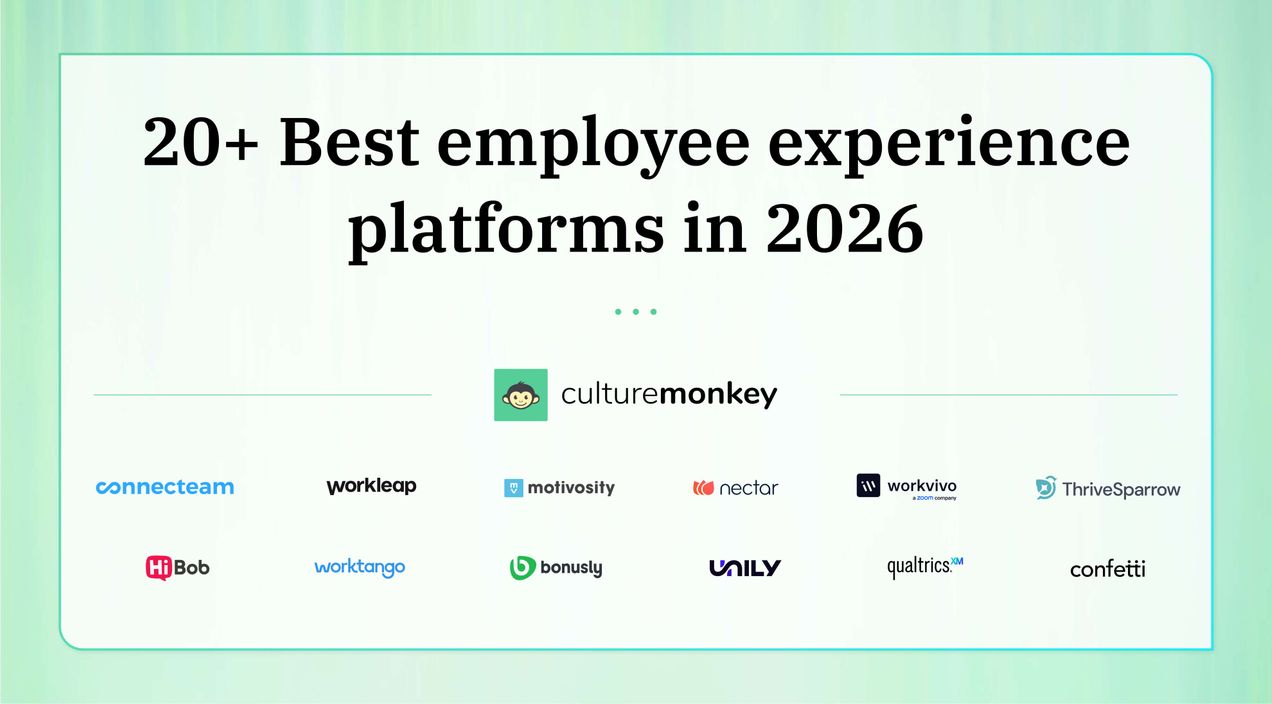Measuring employee experience: Why it matters and how to get it right in 2025

Remember tuning a radio with a twist dial back in the day? You’d sit by the stereo, fingers hovering, slowly nudging the knob left or right. One second it was all static, the next—just a sliver of the song you were dying to hear.
You’d hold your breath, trying to land on that perfect spot where the signal was clear, the music crisp, and the rhythm just right. And sometimes, the dial would slip and you’d be right back to white noise. It wasn’t just about hearing the music—it was about catching the right frequency.
Measuring employee experience is a lot like that. You’re tuning into the signals your people are constantly sending—some loud and obvious, others subtle and layered. But when you get the frequency just right, everything clicks: engagement soars, teams align, and the culture plays in harmony.
TL;DR
What is employee experience?

TL;DR
Employee experience is the sum of perceptions, emotions, and interactions an employee has throughout their journey with an organization, from hiring to exit.
It influences satisfaction, engagement, retention, and overall workplace culture, directly impacting organizational success and growth.
Employee experience (EX) encompasses the perceptions, emotions, and interactions employees have throughout their journey with an organization—from recruitment to exit. It influences job satisfaction, productivity, and overall engagement. A positive EX fosters a motivated workforce, reduces turnover, and boosts organizational and business success too.
Why does employee experience matter?
Employee experience shapes how employees feel, perform, and grow throughout their journey with your organization. A positive experience leads to higher engagement, lower turnover, and stronger team dynamics.
- Fosters belonging: Employees who feel engaged are more motivated and enthusiastic about their work, resulting in higher levels of productivity and fewer instances of absenteeism.
- Reduces turnover: When employees feel connected to their workplace, they are more likely to stay long-term. This stability allows organizations to invest in growth rather than constantly replacing staff.
- Boosts customer service: Employees who feel satisfied and empowered are more likely to go above and beyond for clients, thus creating a ripple effect, improving customer loyalty and the organization’s reputation.
- Encourages innovation: When employees feel supported and inspired, they’re more likely to think creatively and solve problems effectively. This leads to enhanced productivity and groundbreaking ideas that drive the organization forward.
- Strengthens employer brand: This attracts top talent and sets the company apart in competitive industries. A strong employer brand not only aids the recruitment process but also boosts morale among existing employees.
Why is measuring employee experience important?

Measuring employee experience is crucial for a deeper understanding of the realities of your workforce and uncovering hidden insights that drive improvement. It allows organizations to create actionable strategies to enhance engagement, productivity, and workplace satisfaction.
By evaluating employee experience metrics, businesses can align their goals with the needs of their people. Here are 7 reasons why measuring employee experience is important:
1. Identifies pain points
Measuring employee experience helps pinpoint areas where employees face challenges, such as inefficient processes or lack of resources. These insights allow organizations to address specific issues that hinder employee productivity and satisfaction. By resolving pain points, businesses can create a smoother, more fulfilling employee journey.
2. Tracks progress over time
Regular measurement allows organizations to evaluate the impact of their employee-focused initiatives. By tracking changes in key metrics, HR leaders can assess whether strategies are effective. This enables continuous improvement and ensures the organization adapts to the evolving needs of its workforce.
3. Supports data-driven decision making
Metrics provide a concrete foundation for making strategic decisions about workplace policies and programs. Instead of relying on assumptions, leaders can use data to prioritize initiatives that will have the greatest impact. This ensures resources are allocated efficiently and effectively.
4. Improves diversity, equity, and inclusion (DEI)
Measuring employee experience highlights disparities across different demographics within the workforce. This allows organizations to identify gaps and take targeted actions to improve inclusivity. A better understanding of dei ensures all employees feel valued, which strengthens the organization’s culture.
5. Enhances leadership effectiveness
Feedback collected during the measurement process often sheds light on leadership performance and communication gaps. Leaders can use this feedback to refine their management style and build stronger connections with employees. Improved leadership directly contributes to a more positive workplace experience.
6. Boosts employee empowerment
By asking employees for input and acting on the findings, organizations show they value their workforce’s opinions. This fosters a sense of empowerment and trust among employees. When employees feel heard, they are more likely to be engaged and committed to their roles.
7. Supports crisis management and resilience
In times of crisis or rapid change, measuring employee experience provides insights into how employees are coping. It helps organizations identify areas requiring immediate attention and support. Proactively addressing employee wellness concerns ensures the workforce remains resilient and adaptable during challenges.
Framework for measuring employee experience

A well-defined framework for measuring employee experience (EX) provides a structured approach to understanding how employees perceive their journey within an organization. It combines key elements, tools, and methodologies to generate actionable insights. Below is a comprehensive framework on how to measure employee experience effectively:
TL;DR
A framework for measuring employee experience involves identifying key touchpoints, collecting feedback through surveys and metrics, analyzing data for insights, and aligning findings with organizational goals to improve engagement, satisfaction, and retention across the entire employee lifecycle.
- Define objectives and outcomes: Start by identifying what you aim to achieve through measuring employee experience. Are you looking to improve engagement, reduce turnover, or enhance leadership effectiveness? Clear objectives help align measurement efforts with organizational goals.
- Map the employee journey: Break down the employee lifecycle into key stages, such as recruitment, onboarding, development, retention, and exit. Mapping this journey helps identify critical touchpoints where experiences can be assessed.
- Identify key metrics: Determine the metrics that align with your objectives and the employee lifecycle stages. Examples include employee engagement scores, turnover rates, satisfaction ratings, employee Net Promoter Score (eNPS) and feedback frequency. Metrics should be both quantitative (e.g., retention rates) and qualitative (e.g., open-ended survey responses) to provide a complete picture.
- Select data collection methods: Choose the most effective tools to gather data, such as employee surveys, interviews, focus groups, and pulse check-ins. Leverage technology like employee experience platforms to collect real-time feedback. Ensure that the methods chosen are accessible, anonymous, and encourage honest participation.
- Analyze and interpret data: Use analytics tools to process and interpret the data collected. Look for patterns, trends, and correlations that reveal strengths and weaknesses in the employee experience. Advanced techniques, like sentiment analysis or predictive modeling, can offer deeper insights.
- Create and implement action plans: Based on the analysis, design actionable strategies to address areas needing improvement. Collaborate with stakeholders, such as leadership and employees, to prioritize and implement these initiatives. Regularly monitor progress to ensure your actions are making a measurable difference.
Key moments that matter in the employee experience lifecycle
To effectively measure employee experience, organizations must identify and understand the key touchpoints that shape how employees perceive their journey. These pivotal stages contribute to the employee experience score and are essential for gathering meaningful employee insights and tracking key HR metrics.
- Recruitment: Sets expectations through transparent hiring, timely communication, and inclusion. Tracking candidate satisfaction and time‑to‑hire offers early employee insights.
- Onboarding: Builds early connection and reduces time to productivity. Structured programs with mentoring and cultural immersion improve integration and reduce early attrition. Measuring onboarding satisfaction highlights readiness gaps and helps improve physician morale where needed.
- Development: Career growth through training and mobility boosts morale and retention. Feedback and employee insights refine L&D initiatives.
- Performance: Fair, constructive reviews and clear KPIs strengthen trust. Monitoring feedback quality and promotion outcomes ensures employees feel supported and valued.
- Recognition: Timely, meaningful appreciation drives engagement and loyalty. Tracking recognition frequency and its link to engagement scores helps build a positive culture and improve morale.
- Offboarding: A smooth, respectful exit process fosters goodwill and strengthens the employer brand. Exit surveys and attrition metrics reveal trends to guide retention strategies and maintain engagement even post‑employment.
Adapting employee experience measurement for remote and hybrid teams
Measuring employee experience in remote and hybrid work environments requires tailored approaches that reflect the unique challenges of distributed work. Organizations need to adjust their strategies to ensure meaningful engagement and accurate insights.
Here’s how to adapt employee experience measurement effectively:
- Use employee experience surveys designed for remote work: Customize employee experience surveys to capture feedback on virtual collaboration, communication, and work-life balance specific to remote and hybrid employees.
- Track employee experience metrics regularly: Frequent measurement of key employee experience metrics helps identify trends in engagement, satisfaction, and connection across dispersed teams.
- Leverage an employee experience dashboard: A centralized employee experience dashboard enables real-time monitoring of feedback and highlights gaps between on-site and remote experiences.
- Measure with an employee experience index: Using an employee experience index that accounts for remote-specific factors provides a holistic view of how all employees feel, regardless of location.
- Focus on employee relations metrics: Monitor employee relations metrics like manager responsiveness, team cohesion, and conflict resolution to ensure remote workers feel equally supported.
- Empower the employee experience team: Equip your employee experience team with tools and frameworks to design initiatives that engage hybrid and remote staff effectively.
- Benchmark employee experience across work modes: Use employee experience benchmarks to compare and align the experiences of remote, hybrid, and on-site employees.
What is the employee experience index?

The employee experience index (EX Index) is a comprehensive measure used to evaluate how employees perceive their overall experience within an organization. It consolidates key factors such as engagement, satisfaction, well-being, and alignment with company values into a single metric. The employee experience index helps organizations quantify the quality of their workplace environment and identify improvement areas.
Developed by combining data-driven insights and psychological principles, the employee experience index reflects the critical drivers of a positive employee experience. It typically includes components like emotional connection to work, perceived growth opportunities, and the level of trust employees have in leadership.
This index serves as a benchmark, enabling organizations to compare their performance internally over time against key performance indicators and externally against industry standards. The employee experience index is calculated using surveys, exit interviews, feedback tools, and analytics platforms.
Employees provide responses to questions aligned with the core components of the index, such as "I feel valued at work" or "I have the resources I need to succeed." These responses are then aggregated into a numerical score.
By tracking the employee experience index, organizations can prioritize areas of improvement, tailor strategies to enhance workforce engagement, and foster a culture of trust and innovation. It’s a powerful tool to drive meaningful changes and ensure sustained employee satisfaction and retention.
What are the metrics that matter while measuring employee experience?

Tracking the right metrics gives HR leaders actionable insights into engagement, satisfaction, and workplace culture. Here are the key metrics to focus on:
- Employee engagement score: Measures emotional commitment and motivation. High scores indicate enthusiasm, productivity, and improved morale. Often collected through pulse surveys or platforms — especially vital in high‑stress fields to monitor doctor burnout and engagement.
- Employee Net Promoter Score (eNPS): Gauges how likely employees are to recommend the workplace. A higher employee Net Promoter Score, (eNPS) , reflects loyalty and satisfaction.
- Employee retention rate: Shows workforce stability by tracking how many employees stay over time. Low retention may signal morale or engagement issues, making it important to also measure employee retention and improve physician morale in healthcare settings.
- Work‑life balance index: Assesses how well employees juggle work and personal life. Low scores can indicate burnout risks and the need for policy changes.
- Employee satisfaction rating: Captures overall happiness with role, team, and culture. A holistic indicator of workplace sentiment.
- Training and development participation: Tracks involvement in growth opportunities. High participation suggests employees feel supported in their career paths.
- Turnover rate by demographics: Highlights turnover rates and disparities across groups like age, gender, or tenure, helping HR improve fairness and inclusivity.
Quantitative vs. Qualitative Feedback: Why you need both
To truly understand and improve the employee journey, organizations must combine quantitative and qualitative feedback. This balanced approach offers a complete picture of the employee experience and drives accurate, actionable decisions around how to measure employee experience effectively.
| Attribute | Quantitative Feedback | Qualitative Feedback |
|---|---|---|
| Purpose | Tracks measurable metrics like engagement scores, retention rates, and survey ratings. It provides clear benchmarks for employee satisfaction measurement tools. | Captures detailed opinions, emotions, and narratives to understand the “why” behind the numbers and uncover hidden issues. |
| Example tools | Pulse surveys, eNPS, engagement dashboards, and HR analytics platforms help quantify employee experience scores. | Open-ended survey questions, focus groups, and one-on-one interviews offer deeper employee happiness insights. |
| Data nature | Structured and numerical—ideal for spotting trends, comparisons, and benchmarking across teams or time periods. | Unstructured and descriptive—ideal for identifying root causes, exploring context, and understanding emotional drivers. |
| Insights delivered | Answers “what is happening” in the workplace and identifies performance patterns using hard data. | Answers “why it’s happening” and helps shape meaningful improvements through direct employee voice. |
| Best use case | Ideal for tracking key HR metrics over time, setting goals, and evaluating program impact. | Best for exploring culture shifts, evaluating leadership, and validating assumptions revealed by quantitative data. |
How employee experience impacts employee retention and productivity
A positive employee experience fosters loyalty, enhances workplace performance and harbors a positive work environment. When employees feel valued and supported, they are more likely to stay and contribute at their best. Here’s how employee experience directly influences retention and productivity:
- Improves employee satisfaction metrics: When organizations track and improve employee satisfaction metrics, engaged employees feel happier and more engaged, reducing turnover rates.
- Strengthens employee engagement impact on productivity: Higher engagement levels lead to increased focus, motivation, and output, directly boosting team productivity.
- Supports employee experience best practices: Implementing employee experience practices creates a culture where employees can thrive, minimizing burnout, good healthy work-life balance and employee absenteeism.
- Guides employee experience management: A well-defined employee experience management approach helps address concerns proactively, keeping employees committed to the organization.
- Enhances employee experience KPIs: Meeting key employee experience KPIs, such as engagement, satisfaction, and professional development opportunities correlates with improved retention and performance.
- Informs employee experience strategy: A data-driven employee experience strategy aligns employee needs with business goals, leading to sustained loyalty and higher productivity levels.
- Provides actionable employee experience insights: Regularly analyzing employee insights enables organizations to identify and fix issues that may otherwise lead to attrition or underperformance.
How to calculate employee experience?

Calculating employee experience is the process of quantifying various aspects of the employee journey through data and metrics. It involves gathering numerical and qualitative data, analyzing trends, and combining multiple metrics into a single, actionable score or index. Here’s how you can calculate employee experience:
TL;DR
To calculate employee experience, gather data from key metrics like engagement, satisfaction, and retention using surveys and feedback tools. Assign weights to each metric based on importance and compute individual scores.
Combine weighted scores into a single index that reflects overall experience. Use this score to track progress, identify gaps, and guide strategies for improvement.
- Identify key metrics: Define which metrics matter most, such as engagement scores, turnover rates, eNPS, satisfaction ratings, work‑life balance, and training participation, aligned to organizational priorities.
- Collect data: Gather employee feedback through surveys, feedback, pulse checks, interviews, and tools. Track engagement, satisfaction, and sentiment over time for accuracy.
- Assign weight to each metric: Prioritize metrics by importance, ensuring all weights add up to 100%. For example, if engagement is crucial, it may carry 40% weight.
- Calculate individual scores: Compute each metric’s score, such as average engagement survey responses or turnover rate percentages.
- Combine the scores: Multiply each metric by its weight to calculate weighted scores.
- Sum the weighted scores: Add up all weighted scores to arrive at the overall employee experience score or index.
- Interpret the final score: Use the final score to gauge overall experience, track progress over time, and identify areas for improvement.
How often should you measure employee experience?
The frequency of measuring employee experience plays a crucial role in capturing accurate, actionable insights. Too infrequent, and you risk missing trends; too frequent, and you may cause survey fatigue. Striking the right balance ensures meaningful data and employee participation. Here’s how to decide how often to measure employee experience:
- Use regular employee experience surveys: Conduct employee experience surveys at key intervals, such as quarterly or biannually, to track progress and address emerging issues promptly.
- Monitor employee experience metrics continuously: Performance metrics like employee turnover, absenteeism, and engagement levels should be monitored year-round using an employee experience dashboard for ongoing insights.
- Incorporate pulse checks: Short, focused pulse surveys can be sent monthly or after specific events to gather quick employee insights without overwhelming staff and team members.
- Measure at key moments: Align surveys with critical points in the employee journey—onboarding, performance reviews, promotions, or exit—to get contextual feedback.
- Follow your employee experience strategy: Let your employee experience strategy and goals guide frequency. For example, organizations implementing new policies may temporarily increase measurement to monitor impact.
- Benchmark annually: Compare results to employee experience benchmarks at least once a year to assess long-term progress and set future targets.
Top methods for measuring employee experience at every stage
Measuring employee experience effectively requires using the right methods at each stage of the employee journey. Tailored approaches provide meaningful insights into how employees perceive their interactions and help organizations refine their employee experience strategy. Here are the top methods to use at every stage:
- Pre-hire surveys: Gather candidate feedback during the recruitment process to assess how organizational values and communication shape the initial employee experience insights.
- Onboarding feedback forms: Use structured employee experience surveys within the first 30–90 days to understand how new hires perceive training, culture, and team integration.
- Pulse surveys: Send short, regular pulse surveys throughout employment to measure employee experience metrics like engagement, satisfaction, and alignment with goals.
- Employee experience index tracking: Apply an employee experience index to quantify and monitor the overall journey, combining key employee metrics across touchpoints.
- Performance review feedback: Incorporate employee experience questions into performance reviews to evaluate support, fairness, and development opportunities.
- Stay interviews: Conduct one-on-one conversations with employees to identify what keeps them engaged and what improvements could enhance their experience.
- Recognition analytics: Use employee experience dashboards and tools for measuring employee engagement to analyze recognition frequency and its impact on morale.
- Exit interviews and surveys: Collect employee experience data at the offboarding stage to uncover trends, improve retention, and strengthen future experiences.
Best practices for improving employee experience based on metrics

Improving employee experience requires actionable strategies rooted in data. By analyzing key metrics such as engagement scores, retention rates, and feedback, organizations can implement targeted initiatives to boost satisfaction and performance.
Here are five best practices for improving employee experience based on these metrics:
TL;DR
Act on employee feedback quickly, enhance career development opportunities, improve leadership communication, and support work-life balance to boost satisfaction and engagement.
Foster a culture of recognition and use employee experience metrics to guide targeted initiatives. Consistently aligning actions with data helps strengthen morale, retention, and overall workplace performance.
- Act on feedback in real time: Use pulse surveys and instant feedback tools to address concerns quickly, showing employees they are heard and valued.
- Provide career development opportunities: Use training and growth metrics to design personalized development paths, boosting motivation, retention, and satisfaction.
- Enhance leadership and communication: If feedback highlights leadership gaps, invest in leadership training and foster transparent, approachable communication.
- Improve work‑life balance: Address stress and burnout revealed by work‑life balance data through flexible hours, remote options, or additional leave policies.
- Foster a culture of recognition: Leverage satisfaction and eNPS scores to gauge appreciation levels, and strengthen recognition programs to create a positive, motivated culture.
What metrics matter most when evaluating employee experience
Evaluating employee experience effectively means focusing on the right metrics that reflect both how employees feel and how they perform. These metrics help organizations track progress, uncover challenges, and refine their employee experience strategy. Here are the most important metrics to monitor:
- Employee engagement score: Measures emotional commitment and motivation, often through employee experience surveys or tools for measuring employee engagement.
- Employee satisfaction metrics: Reflect overall happiness with roles, employee life cycle, culture, and leadership, offering a holistic view of workplace sentiment.
- Employee experience index: Combines multiple employee experience metrics into a single score that tracks progress across the employee journey.
- Retention and turnover rates: Show how effectively your organization keeps employees, often linked to the quality of the employee experience.
- Employee experience KPIs: Includes specific goals like onboarding satisfaction, time-to-productivity, and internal mobility rates.
- Work-life balance indicators: Highlights how well employees manage personal and professional responsibilities, helping prevent burnout and disengagement.
- Recognition and rewards data: Tracks how often and how meaningfully employees are recognized, which impacts morale and engagement.
- Employee relations metrics: Monitors workplace relationshipss, fairness, and resolution of conflicts, ensuring a healthy culture.
Common mistakes to avoid when measuring employee experience
While measuring employee experience is crucial for organizational growth, many companies fall into common traps that undermine the accuracy and usefulness of their efforts. Avoiding these missteps is essential to ensure your employee experience monitoring is both strategic and impactful.
- Focusing only on annual surveys: Relying solely on yearly engagement surveys creates blind spots in the employee journey. Without continuous feedback, organizations miss real-time shifts in sentiment. Incorporating pulse surveys, exit interviews, and continuous listening tools supports more dynamic employee experience analytics.
- Ignoring qualitative feedback: Numbers alone can’t capture the emotional drivers behind employee satisfaction. When open-ended responses and interviews are overlooked, key insights are missed. A mix of qualitative and quantitative data is essential to understand root causes and act on concerns effectively.
- Not segmenting data by employee groups: Failing to analyze HR metrics that matter—such as department, tenure, or demographic breakdowns—can mask disparities in experience. Segmentation highlights unique challenges and helps leaders tailor strategies for diverse employee needs.
- Overlooking follow-up action: Gathering feedback without acting on it creates distrust. If employees don’t see changes after surveys, participation drops. Follow-up communication and visible improvements are critical parts of a credible employee experience monitoring strategy.
- Measuring too many or irrelevant metrics: Tracking every data point can dilute focus and overwhelm decision-makers. Instead, prioritize actionable insights tied to business goals using streamlined employee experience analytics. This ensures clarity and impact from your measurement efforts.
Employee experience vs. Employee engagement: Key differences
Although employee experience and employee engagement are closely related, they are distinct concepts that contribute differently to workplace culture and performance. Understanding the differences helps HR leaders craft more effective strategies. Here are the key distinctions:
| Aspect | Employee Experience | Employee Engagement |
|---|---|---|
| Definition | The overall journey and interactions employees have with the organization. | The emotional commitment employees feel toward their work and goals. |
| Scope | Broader, covering every touchpoint from recruitment to exit. | A component within the overall employee experience. |
| Measurement | Uses diverse employee experience metrics like wellness, satisfaction, retention, and development. | Focuses on motivation, effort, and enthusiasm. |
| Focus areas | Includes work environment, employee wellness, culture, tools, and policies. | Emphasizes connection to company mission, recognition, and discretionary effort. |
| Outcomes | Builds a supportive, inclusive culture for long-term organizational success. | Directly impacts productivity, innovation, and team morale. |
| Strategy | Supports long-term organizational health and continuous improvement. | Often targets specific short-term behaviors or attitudes. |
Tools and platforms that help measure EX holistically
To understand and enhance every stage of the employee journey, organizations must adopt a combination of tools that provide a 360-degree view of the workforce. These platforms not only support employee experience monitoring but also align daily operations with long-term goals.
- Employee survey platforms: Collect sentiment at key touchpoints like onboarding, engagement, and exit. Tools like CultureMonkey help to see valuable insights like real‑time feedback, trend analysis, and actionable reporting to improve EX.
- Performance management systems: Integrated performance tracking helps to track goals, feedback, and reviews to assess productivity, engagement, and alignment with business objectives.
- Recognition and reward platforms: Monitor recognition trends and peer acknowledgments by using platforms to track recognition trends to gauge how valued employees feel and strengthen morale.
- Communication and collaboration tools: Effective internal communication tools analyzes usage and interaction data to understand team connectivity and employee engagement levels.
- HR analytics dashboards: Centralize feedback data, retention, and engagement for a holistic view of trends and pain points.
Connecting employee experience with customer experience (CX)
Employee experience has a direct influence on customer satisfaction and loyalty. When employees feel supported and engaged, they deliver better service, reflecting positively on the customer journey. Here’s how organizations can align employee experience with customer experience effectively:
- Focus on employee experience insights: Gathering valuable insights through employee surveys and feedback helps identify gaps that may affect how happy employees interacting with customers.
- Leverage employee experience metrics: Tracking employee experience metrics such as engagement, satisfaction, and recognition can reveal trends that impact customer-facing behavior.
- Build an employee experience dashboard: A centralized dashboard enables HR and managers to monitor employee experience data alongside customer experience data for actionable decisions.
- Adopt an employee experience strategy: A clear employee experience strategy ensures employees are motivated and equipped to deliver consistent, high-quality customer service.
- Measure with an employee experience index: Using an employee experience index helps quantify the connection between internal culture and external customer outcomes.
- Train the employee experience team: Empower your employee experience team to design initiatives that boost morale and create a customer-centric mindset across departments.
- Benchmark employee experience for retention and service: Comparing employee experience benchmarks helps organizations understand how their company culture stacks up and how it influences customer loyalty.
The future of employee experience: Trends to watch
As workplaces evolve, so do employee expectations and the ways organizations measure and enhance employee experience. Staying ahead of these trends helps HR teams create meaningful, future-ready strategies. Here are key employee experience trends to watch:
- Increased focus on employee experience insights: Organizations are investing more in gathering and analyzing employee insights to make data-driven, informed decisions that shape workplace culture.
- Advanced employee experience dashboards: Dashboards are becoming more sophisticated, combining real-time employee experience metrics, KPIs, and benchmarks for better visibility and action.
- Personalized employee experience strategies: Tailoring the employee experience to individual needs and preferences is becoming a core part of employee experience management.
- Integration of employee engagement and experience: More companies are aligning measuring employee engagement and employee experience frameworks to understand the full impact on productivity and retention.
- Adoption of employee experience best practices: HR teams are formalizing employee experience best practices to ensure consistency and scalability across teams and regions.
- Stronger employee experience teams: Dedicated employee experience teams are emerging to focus exclusively on improving culture, satisfaction, and retention.
- Focus on employee experience benchmarks and examples: Organizations are looking to industry benchmarks and employee experience case studies to set goals and inspire improvement.
Significance of staff experience surveys in measuring employee experience

Staff experience surveys play a crucial role in capturing employees’ perceptions and sentiments at various stages of their journey with an organization.
These surveys provide valuable data that helps organizations understand what is working well and what needs improvement. By regularly collecting feedback, companies can enhance engagement, satisfaction, and overall productivity. Here’ why staff experience surveys are significant:
- Provide direct insight into employee sentiment: Staff surveys give employees a platform to express their views on various aspects of the workplace, including leadership, culture, and job satisfaction. This direct feedback helps organizations understand how employees feel about their roles and work environment.
- Identify areas for improvement: Surveys allow organizations to pinpoint specific pain points or areas that need attention, such as communication gaps, workload issues, or management concerns. Addressing these areas based on survey results can lead to targeted improvements and a better employee experience.
- Measure employee engagement: Employee engagement is a critical factor in overall satisfaction and productivity. Staff experience surveys help assess the level of employee engagement by asking questions about motivation, emotional connection to the work, and alignment with company values.
- Track progress over time: By conducting regular surveys, companies can track changes in employee sentiment over time. This trend analysis allows organizations to measure the effectiveness of initiatives designed to improve the employee experience and make necessary adjustments.
- Encourage a culture of open communication: Staff experience surveys demonstrate that the organization values employee input and is committed to continuous improvement. When employees see that their feedback is taken seriously, it fosters a culture of trust and open communication, leading to increased engagement and satisfaction.
Conclusion
Measuring employee experience isn’t just a feel-good initiative—it’s a strategic imperative. When you consistently listen to your people, you unlock insights that drive engagement, performance, and increase employee retention.
From pinpointing friction in the employee journey to spotting trends before they become problems, employee experience measurement gives you the clarity to lead with confidence. It's not about checking a box—it's about creating a culture where every voice matters and every experience counts.
With CultureMonkey, turning insights into action becomes effortless. With real-time feedback tools, customizable surveys, and powerful analytics, CultureMonkey makes it simple to track employee experience KPIs, understand sentiment, and act swiftly.
Whether you’re building trust, improving communication, or boosting morale, the platform helps you stay tuned in to what really matters—your people. If you're ready to stop guessing and start listening, CultureMonkey helps you measure smarter, act faster, and lead better.
Summary
FAQs
1. What are the most effective tools for measuring employee experience?
CultureMonkey is one of the most effective tools for measuring employee experience. It offers real-time feedback, pulse surveys, and engagement tracking. Its user-friendly platform allows companies to gather insights on employee satisfaction, identify trends, and implement improvements efficiently. CultureMonkey’s comprehensive reporting and analytics helps businesses act on feedback and continuously enhance the employee experience.
2. How does employee experience impact retention and engagement?
Employee experience directly influences both retention and engagement. A positive experience increases employees' emotional connection to their work, improving motivation, productivity, and work performance. Engaged employees are more likely to stay with the company, while a negative experience can lead to higher turnover. Ensuring a great employee experience boosts loyalty and fosters long-term retention.
3. What are the differences between employee engagement and employee experience?
Employee engagement focuses on how motivated and emotionally invested employees are in their work. Employee experience, however, encompasses the entire journey, from recruitment to exit, considering all touchpoints and factors influencing satisfaction, such as work environment, growth opportunities, and management style. While engagement measures involvement and commitment, experience reflects overall workplace culture, resources, and growth opportunities.
4. Can small businesses effectively measure employee experience?
Yes, small businesses can effectively measure employee experience. Tools like CultureMonkey make it accessible by offering affordable, user-friendly platforms tailored for smaller organizations. Regular feedback surveys, one-on-one meetings, and focus groups can help small businesses gather insights into employee satisfaction and engagement, providing valuable data to improve company culture, retention, and employee productivity.
5. How often should companies evaluate employee experience metrics?
Companies should evaluate employee experience metrics regularly, ideally quarterly or bi-annually. This allows organizations to track changes, respond to feedback promptly, and adjust strategies as needed. Frequent evaluations, especially with tools like CultureMonkey, help ensure that employee concerns are addressed in real-time and that the workplace remains adaptive to evolving needs boosting retention and engagement.
6. Can measuring EX help reduce turnover and improve engagement?
Yes, measuring employee experience (EX) can significantly reduce turnover and improve engagement. By identifying pain points, tracking sentiment, and addressing concerns in real-time, organizations can create a more supportive and engaging environment. This proactive approach also helps lower employee absenteeism, as employees feel more valued, connected, and motivated to contribute consistently to their roles enhancing the overall job satisfaction levels.
7. What metrics best reflect positive employee experience?
Metrics that best reflect a positive employee experience include employee engagement scores, eNPS (employee net promoter score), satisfaction ratings, retention rates, and feedback participation levels. These metrics offer insight into how valued and connected employees feel. Tracking them regularly helps identify trends, boost morale, and reduce issues like disengagement or employee burnout before they escalate.
8. Can software help measure the full employee lifecycle?
Yes, software can effectively measure the full employee lifecycle by collecting, analyzing, and reporting data at every stage — from recruitment to exit. Tools like employee experience dashboards, survey platforms, and HR analytics centralize feedback, track key metrics, and provide actionable insights. This enables organizations to monitor trends, benchmark performance, and improve engagement, satisfaction, and retention through data-driven decisions.
9. How do you measure EX for remote or hybrid teams?
Measuring employee experience for remote or hybrid teams uses digital surveys, pulse checks, and engagement tools designed for virtual challenges. Key metrics include communication, work-life balance, and team connection, tracked via dashboards and feedback. Regular check-ins, qualitative insights, and benchmarks ensure remote employees feel supported, engaged, and aligned with organizational goals, despite being distributed.
10. How does CultureMonkey track and visualize employee experience?
CultureMonkey measures employee experience using real-time surveys, feedback tools, and dashboards. It gathers insights across the employee lifecycle — from onboarding to exit — and converts them into actionable metrics, KPIs, and benchmarks. By highlighting trends, sentiment, and improvement areas, it helps HR teams make data-driven decisions to boost satisfaction, retention, and workplace culture.
11. Why is employee sentiment analysis important for EX?
Employee sentiment analysis is vital for employee experience as it reveals how employees genuinely feel about work, leadership, and culture. By analyzing surveys, feedback, and communication, organizations gain insights beyond metrics, uncover hidden issues, predict disengagement, and design initiatives that boost morale, engagement, and retention, keeping employee experience positive and aligned with organizational goals.



